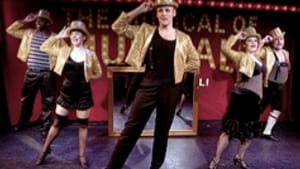Stay in the Loop
BSR publishes on a weekly schedule, with an email newsletter every Wednesday and Thursday morning. There’s no paywall, and subscribing is always free.
A simple tale, in the hands of five Broadway composers
"Musical of Musicals' at Walnut Studio 3 (1st review)

I almost missed Musical of Musicals, the Musical during its recent run at Independence Studio 3 above the Walnut Street Theatre. I'd seen the show twice before and liked it, but this time turned out to be the best of all— first, because the wonderful material keeps revealing new subtleties; and second, because we can appreciate this superb cast even more when we see them up close in an intimate space.
In this Eric Rockwell-Joanne Bogart parody, a simple story about how rent is due is told five times in the recognizable styles of theater giants Rodgers and Hammerstein, Stephen Sondheim, Andrew Lloyd Weber, Kander and Ebb and Jerry Herman. A bonus finale is a takeoff on Marvin Hamlisch's A Chorus Line.
Melodies are not quoted. That would be too obvious. Instead, the show takes facets that made each of these songwriters famous and exaggerates them to the point of humor. Styles are hinted at, such as Sondheim's tendency to use sing-songy repetition of notes. In the case of Andrew Lloyd Webber, it's his recycling of Puccini-like romantic melodies.
The lyrics, too, are parodies. With Rodgers and Hammerstein, it's their writing about how people are not in love: If I loved you; People will say we're in love (but we're not), and so on. With Jerry Herman it's effusive paeans to glamorous ladies. With Sondheim it's angst. With Kander & Ebb it's an insistence that the world is a cesspool.
Demon barber in a housing complex
Within each section that's based on a specific songwriter lies a conflation of the plots of several shows. For example, the Sondheim section stars a character who looks and sounds like the demon barber of Fleet Street, living in a housing complex (as Sondheim's creations are all complex— get it?) called The Woods. When we enter The Woods, we see that the barber has many visitors. Bells ring and doors open, just as in Sondheim's Company. A lyric captures the essence of Sondheim creations: "Don't feel obtuse / Yes, it's abstruse / Every one here has at least one screw loose."
In the Rodgers and Hammerstein section, we see a mixture of images from Carousel, The King and I, Oklahoma! and South Pacific. The cast sings: "The earth spins around like a carousel;/ On bright clouds of music we fly./ The cattle plié in a dreamy ballet;/ It's as normal as blueberry pie."
The Kander and Ebb portion is set in a sleazy cabaret in Berlin: "The world can go to blazes;/ Who cares? It doesn't faze us./ We've got booze/ And songs that use /A lot of foreign phrases."
Also in this segment we get a particularly inside song reference. "See the guard by the door?/ Color him blue./ See the guy with the grey hat and coat?/ Color him...grey." How many audience members will remember that Kander and Ebb wrote a pop song in 1962— the year they met— called "My Coloring Book," with similar words?
Sondheim mocked
It's fascinating how Bogart captured the verbal style of each songwriter and then threw in jokes of her own that comment on the style. For example, in a mockery of Sondheim word-patterns as well as his obsession with colors, a character sings: "Finders can be weepers;/ Losers can be keepers./ Roses can be red;/ Violets can be blue;/ Some lyrics rhyme,/ Some don't."
In a change of pace, the Jerry Herman satire is set in the glamorous apartment of a woman with a fabulous wardrobe, like Auntie Mame. Naturally, she throws a party and wonders if she supplied enough food. Her song is in the style of "If He Walked Into My Life...Did I give enough? Did I give too much?" She sings: "Did I put out enough?"
Someone asks for more hors d'oeuvres: "Where's that boy with the bagel?" This echoes a line from Mame, when the title character described her nephew as "the boy with the bugle." My 16-year-old son didn't get this pun. But one of the pleasures of the show is that allusions fly rapidly by. If you can't catch one joke, others will grab you a moment later. Some pre-teens in the audience laughed throughout the show.
From Fosse to Michael Bennett
In the original 2003 New York staging, the composer was one of the four singers and also played the piano. The Walnut production adds a separate pianist who also recites stage directions and joins the singing. Alex Bechtel, in these roles, adds greatly to the show's success.
Carl Clemons-Hopkins is astoundingly good as one of the leading men. His singing voice is powerful, and he successfully executes dance steps like an Agnes de Mille cowboy, a Bob Fosse sloucher and a Michael Bennett strutter. Sarah Gliko (whom I enjoyed as Lily Van Voorhees in The Holiday Show) was an endearing ingénue, while Rebecca Robbins was a worthy leading lady who made Joanne Bogart's roles into her own, with hints of Patti LuPone and Angela Lansbury.
Director Craig Fols, who was the boy ingénue in the original cast, moved to portraying darker characters, like Sweeney Todd and the Phantom. As his voice has matured, this switch adds dimension.
Let's hope this production will re-surface. Audiences deserve a chance to see it again, here and in other cities. Meanwhile, the original cast can be heard in a CD recording on the Jay label. And I look forward to the next appearances by each of these cast members.♦
To read another review by Judy Weightman, click here.
In this Eric Rockwell-Joanne Bogart parody, a simple story about how rent is due is told five times in the recognizable styles of theater giants Rodgers and Hammerstein, Stephen Sondheim, Andrew Lloyd Weber, Kander and Ebb and Jerry Herman. A bonus finale is a takeoff on Marvin Hamlisch's A Chorus Line.
Melodies are not quoted. That would be too obvious. Instead, the show takes facets that made each of these songwriters famous and exaggerates them to the point of humor. Styles are hinted at, such as Sondheim's tendency to use sing-songy repetition of notes. In the case of Andrew Lloyd Webber, it's his recycling of Puccini-like romantic melodies.
The lyrics, too, are parodies. With Rodgers and Hammerstein, it's their writing about how people are not in love: If I loved you; People will say we're in love (but we're not), and so on. With Jerry Herman it's effusive paeans to glamorous ladies. With Sondheim it's angst. With Kander & Ebb it's an insistence that the world is a cesspool.
Demon barber in a housing complex
Within each section that's based on a specific songwriter lies a conflation of the plots of several shows. For example, the Sondheim section stars a character who looks and sounds like the demon barber of Fleet Street, living in a housing complex (as Sondheim's creations are all complex— get it?) called The Woods. When we enter The Woods, we see that the barber has many visitors. Bells ring and doors open, just as in Sondheim's Company. A lyric captures the essence of Sondheim creations: "Don't feel obtuse / Yes, it's abstruse / Every one here has at least one screw loose."
In the Rodgers and Hammerstein section, we see a mixture of images from Carousel, The King and I, Oklahoma! and South Pacific. The cast sings: "The earth spins around like a carousel;/ On bright clouds of music we fly./ The cattle plié in a dreamy ballet;/ It's as normal as blueberry pie."
The Kander and Ebb portion is set in a sleazy cabaret in Berlin: "The world can go to blazes;/ Who cares? It doesn't faze us./ We've got booze/ And songs that use /A lot of foreign phrases."
Also in this segment we get a particularly inside song reference. "See the guard by the door?/ Color him blue./ See the guy with the grey hat and coat?/ Color him...grey." How many audience members will remember that Kander and Ebb wrote a pop song in 1962— the year they met— called "My Coloring Book," with similar words?
Sondheim mocked
It's fascinating how Bogart captured the verbal style of each songwriter and then threw in jokes of her own that comment on the style. For example, in a mockery of Sondheim word-patterns as well as his obsession with colors, a character sings: "Finders can be weepers;/ Losers can be keepers./ Roses can be red;/ Violets can be blue;/ Some lyrics rhyme,/ Some don't."
In a change of pace, the Jerry Herman satire is set in the glamorous apartment of a woman with a fabulous wardrobe, like Auntie Mame. Naturally, she throws a party and wonders if she supplied enough food. Her song is in the style of "If He Walked Into My Life...Did I give enough? Did I give too much?" She sings: "Did I put out enough?"
Someone asks for more hors d'oeuvres: "Where's that boy with the bagel?" This echoes a line from Mame, when the title character described her nephew as "the boy with the bugle." My 16-year-old son didn't get this pun. But one of the pleasures of the show is that allusions fly rapidly by. If you can't catch one joke, others will grab you a moment later. Some pre-teens in the audience laughed throughout the show.
From Fosse to Michael Bennett
In the original 2003 New York staging, the composer was one of the four singers and also played the piano. The Walnut production adds a separate pianist who also recites stage directions and joins the singing. Alex Bechtel, in these roles, adds greatly to the show's success.
Carl Clemons-Hopkins is astoundingly good as one of the leading men. His singing voice is powerful, and he successfully executes dance steps like an Agnes de Mille cowboy, a Bob Fosse sloucher and a Michael Bennett strutter. Sarah Gliko (whom I enjoyed as Lily Van Voorhees in The Holiday Show) was an endearing ingénue, while Rebecca Robbins was a worthy leading lady who made Joanne Bogart's roles into her own, with hints of Patti LuPone and Angela Lansbury.
Director Craig Fols, who was the boy ingénue in the original cast, moved to portraying darker characters, like Sweeney Todd and the Phantom. As his voice has matured, this switch adds dimension.
Let's hope this production will re-surface. Audiences deserve a chance to see it again, here and in other cities. Meanwhile, the original cast can be heard in a CD recording on the Jay label. And I look forward to the next appearances by each of these cast members.♦
To read another review by Judy Weightman, click here.
What, When, Where
The Musical of Musicals, the Musical. Music by Eric Rockwell; lyrics by Joanne Bogart, book by Rockwell and Bogart; Craig Fols directed. Through June 27, 2010 at Walnut Street Theatre, Independence Studio on 3, 825 Walnut St. (215) 574-3550 or www.walnutstreettheatre.org.
Sign up for our newsletter
All of the week's new articles, all in one place. Sign up for the free weekly BSR newsletters, and don't miss a conversation.

 Steve Cohen
Steve Cohen